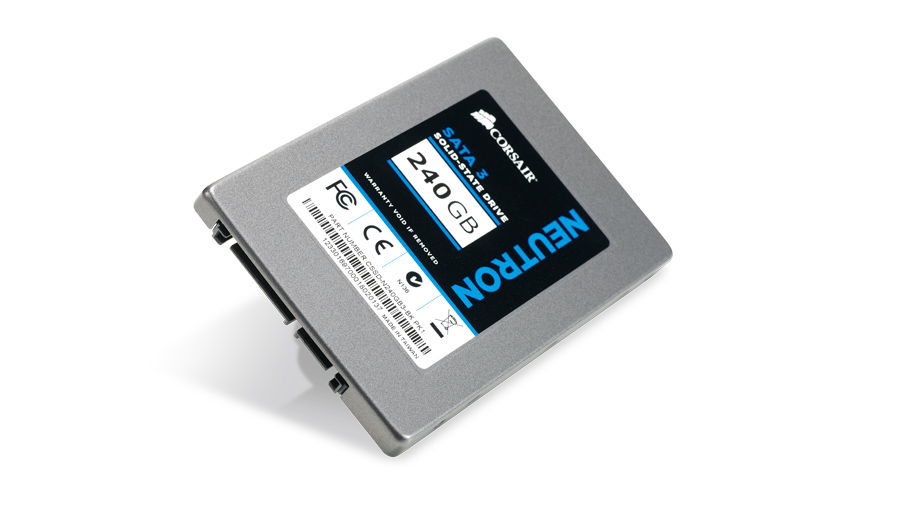TechRadar Verdict
Pros
- +
Good 4K read/write
- +
Almost matches Neutron GTX performance
- +
Decent price
Cons
- -
Write speeds not the best
Why you can trust TechRadar
Once upon a time, it was as simple as asynchronous NAND bad, synchronous NAND good. Well, as simple as things get when you're talking about the workings of an SSD.
Synchronous NAND was capable of producing very similar synthetic benchmark results to asynchronous, using a streamlined design and eliminating clock signals, but they both compromised on real world performance.
Then along came toggle NAND and gave us all confusion-nosebleeds. It works very similarly to async, but with awesome power efficiency and real-world performance.
So a year ago, if you heard Corsair was releasing two models of a drive controlled by the same Link A Media Systems controller - one with ONFi Micron synchronous NAND and the other with toggle - you might a) ask who the hell Link A Media Systems is, and b) assume that this sync Neutron would be superior.
Well guess what? Technology is a misleading scallywag. In a direct head-to-head between the Neutron and the slightly more expensive Neutron GTX with toggle NAND, the latter just about comes up trumps.
Firstly, a few provisos: the Neutron's around $45 cheaper than the GTX, and both weigh in at 240GB. What you're paying extra for with the GTX is insane IOPS levels - the kind you'd only really notice in a professional environment (audio/video/image editing, rather than gaming in a shirt and tie).
If you're just looking for quicker level loading times and speedier Windows boots, the difference is imperceptible until you start poking around with synthetic benchmarks or installing Windows 7 while holding a stopwatch - that's what your friendly neighbourhood PCF is for.
Benchmarks
The biggest performance difference between the Neutron and GTX comes in sequential writes from the AS SSD and ATTO benchmarks.
If you look at the Windows 7 install times though, your concerns should be allayed. And while the two Corsairs duke it out, OCZ makes a strong case for itself as a well-priced, all-round performer.
Sequential read/write
ATTO: Megabytes per second: Bigger is better
CORSAIR NEUTRON 240 GB: Read: 555 / Write: 355
CORSAIR NEUTRON GTX 240 GB: Read: 559 / Write: 512
OCZ VERTEX 4 256 GB: Read: 542 / Write: 470
4K random read/write
AS SSD: Megabytes per second: Bigger is better
CORSAIR NEUTRON 240 GB: Read: 26 / Write: 82
CORSAIR NEUTRON GTX 240 GB: Read: 25 / Write: 60
OCZ VERTEX 4 256 GB: Read: 26 / Write: 96
Installation performance
Windows 7: Minutes and seconds: Lower is better
CORSAIR NEUTRON 240 GB: 8 Mins 38 secs
CORSAIR NEUTRON GTX 240 GB: 8 Mins 41 secs
OCZ VERTEX 4 256 GB:8 Mins 45 secs
In fact, the Neutron excels at 4K random reads and writes. These are the kind of tiny file operations that determine how quickly a folder loads or the thumbnails within appear, so you do notice a difference, and suddenly you feel like the Neutron is $45 well saved.
But then you look at the disparity in sequential write speeds - 511MB/s for the Neutron GTX (and it really can deliver that figure) and just 370MB/s for the Neutron (which we found was more like 355MB/s in actuality). That's a big difference, and since the drives use the same controller it comes down to NAND type and firmware effectiveness.
The GTX option starts to look more attractive at this point, boasting superior sequential figures and effective firmware that seems to squeeze the most from every die.
It's worth mentioning that if you're capacity-conscious, the 240GB listed on the back of the box works out at closer to 223GB when the drive's spare space is taken into account. The SSD housekeeping area, if you will.
But that's true of the GTX version too. OCZ's Vertex 4 256GB is a better option at this price point if you've got a lot to squeeze on one drive. The firmware will let you adjust this allocation space slightly though.
While the Neutron GTX really steals the show in this dual-release, the Neutron has a lot to offer too, and although it's considerably down on write speeds, the real-world performance isn't anything to worry about.

Ad creative by day, wandering mystic of 90s gaming folklore by moonlight, freelance contributor Phil started writing about games during the late Byzantine Empire era. Since then he’s picked up bylines for The Guardian, Rolling Stone, IGN, USA Today, Eurogamer, PC Gamer, VG247, Edge, Gazetta Dello Sport, Computerbild, Rock Paper Shotgun, Official PlayStation Magazine, Official Xbox Magaine, CVG, Games Master, TrustedReviews, Green Man Gaming, and a few others but he doesn’t want to bore you with too many. Won a GMA once.
